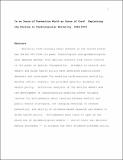Is an Ounce of Prevention Worth an Ounce of Cure? Explaining the Decline in Cardiovascular Mortality, 1964-2010

View/
Metadata
Show full item recordCitation
Greene, Jeremy, and David S. Jones. 2011. "Is an Ounce of Prevention Worth an Ounce of Cure? Explaining the Decline in Cardiovascular Mortality, 1964-2010." Paper presented at Between the medical and the social: Institutions of Chronic Disease and Disability in the Twentieth Century, Paris, 10 Dec. 2011.Abstract
Mortality from coronary heart disease in the United States has fallen 60% from its peak. Cardiologists and epidemiologists have debated whether this decline reflects risk factor control or the power of medical therapeutics. Attempts to resolve this debate and guide health policy have generated sophisticated datasets and techniques for modeling cardiovascular mortality. Neither effort, however, has provided specific guidance for health policy. Historical analysis of the decline debate and the development of cardiovascular modeling offers valuable lessons for policymakers about tensions between medical and public health strategies, the changing meanings of disease prevention, and ability of evidence-based research and models to guide health policy. Policymakers must learn to open up the black box of epidemiological models -- and of their own decision making processes -- to produce the best evidence-informed policy.Other Sources
http://www.ncbi.nlm.nih.gov/pubmed/23048106Terms of Use
This article is made available under the terms and conditions applicable to Open Access Policy Articles, as set forth at http://nrs.harvard.edu/urn-3:HUL.InstRepos:dash.current.terms-of-use#OAPCitable link to this page
http://nrs.harvard.edu/urn-3:HUL.InstRepos:12111381
Collections
- FAS Scholarly Articles [18292]
Contact administrator regarding this item (to report mistakes or request changes)


